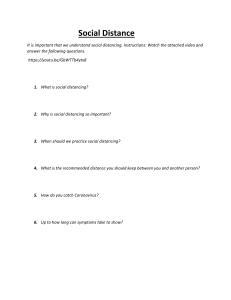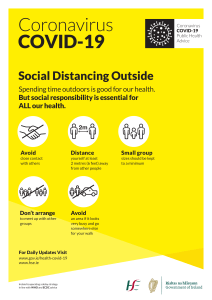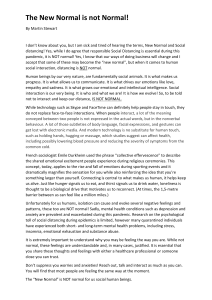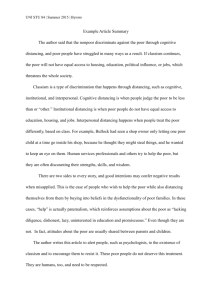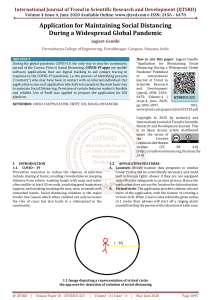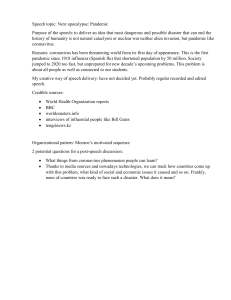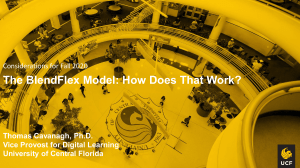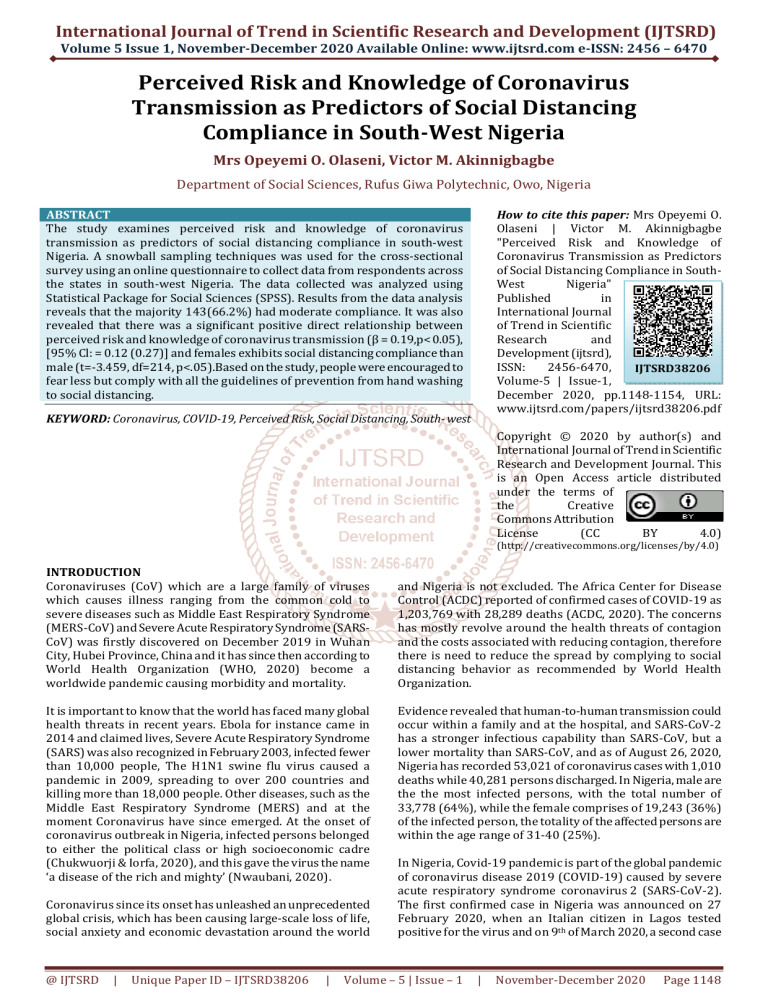
International Journal of Trend in Scientific Research and Development (IJTSRD)
Volume 5 Issue 1, November-December 2020 Available Online: www.ijtsrd.com e-ISSN: 2456 – 6470
Perceived Risk and Knowledge of Coronavirus
Transmission as Predictors of Social Distancing
Compliance in South-West Nigeria
Mrs Opeyemi O. Olaseni, Victor M. Akinnigbagbe
Department of Social Sciences, Rufus Giwa Polytechnic, Owo, Nigeria
How to cite this paper: Mrs Opeyemi O.
Olaseni | Victor M. Akinnigbagbe
"Perceived Risk and Knowledge of
Coronavirus Transmission as Predictors
of Social Distancing Compliance in SouthWest
Nigeria"
Published
in
International Journal
of Trend in Scientific
Research
and
Development (ijtsrd),
ISSN:
2456-6470,
IJTSRD38206
Volume-5 | Issue-1,
December 2020, pp.1148-1154, URL:
www.ijtsrd.com/papers/ijtsrd38206.pdf
ABSTRACT
The study examines perceived risk and knowledge of coronavirus
transmission as predictors of social distancing compliance in south-west
Nigeria. A snowball sampling techniques was used for the cross-sectional
survey using an online questionnaire to collect data from respondents across
the states in south-west Nigeria. The data collected was analyzed using
Statistical Package for Social Sciences (SPSS). Results from the data analysis
reveals that the majority 143(66.2%) had moderate compliance. It was also
revealed that there was a significant positive direct relationship between
perceived risk and knowledge of coronavirus transmission (β = 0.19,p< 0.05),
[95% Cl: = 0.12 (0.27)] and females exhibits social distancing compliance than
male (t=-3.459, df=214, p<.05).Based on the study, people were encouraged to
fear less but comply with all the guidelines of prevention from hand washing
to social distancing.
KEYWORD: Coronavirus, COVID-19, Perceived Risk, Social Distancing, South- west
Copyright © 2020 by author(s) and
International Journal of Trend in Scientific
Research and Development Journal. This
is an Open Access article distributed
under the terms of
the
Creative
Commons Attribution
License
(CC
BY
4.0)
(http://creativecommons.org/licenses/by/4.0)
INTRODUCTION
Coronaviruses (CoV) which are a large family of viruses
which causes illness ranging from the common cold to
severe diseases such as Middle East Respiratory Syndrome
(MERS-CoV) and Severe Acute Respiratory Syndrome (SARSCoV) was firstly discovered on December 2019 in Wuhan
City, Hubei Province, China and it has since then according to
World Health Organization (WHO, 2020) become a
worldwide pandemic causing morbidity and mortality.
It is important to know that the world has faced many global
health threats in recent years. Ebola for instance came in
2014 and claimed lives, Severe Acute Respiratory Syndrome
(SARS) was also recognized in February 2003, infected fewer
than 10,000 people, The H1N1 swine flu virus caused a
pandemic in 2009, spreading to over 200 countries and
killing more than 18,000 people. Other diseases, such as the
Middle East Respiratory Syndrome (MERS) and at the
moment Coronavirus have since emerged. At the onset of
coronavirus outbreak in Nigeria, infected persons belonged
to either the political class or high socioeconomic cadre
(Chukwuorji & Iorfa, 2020), and this gave the virus the name
‘a disease of the rich and mighty’ (Nwaubani, 2020).
Coronavirus since its onset has unleashed an unprecedented
global crisis, which has been causing large-scale loss of life,
social anxiety and economic devastation around the world
@ IJTSRD
|
Unique Paper ID – IJTSRD38206
|
and Nigeria is not excluded. The Africa Center for Disease
Control (ACDC) reported of confirmed cases of COVID-19 as
1,203,769 with 28,289 deaths (ACDC, 2020). The concerns
has mostly revolve around the health threats of contagion
and the costs associated with reducing contagion, therefore
there is need to reduce the spread by complying to social
distancing behavior as recommended by World Health
Organization.
Evidence revealed that human-to-human transmission could
occur within a family and at the hospital, and SARS-CoV-2
has a stronger infectious capability than SARS-CoV, but a
lower mortality than SARS-CoV, and as of August 26, 2020,
Nigeria has recorded 53,021 of coronavirus cases with 1,010
deaths while 40,281 persons discharged. In Nigeria, male are
the the most infected persons, with the total number of
33,778 (64%), while the female comprises of 19,243 (36%)
of the infected person, the totality of the affected persons are
within the age range of 31-40 (25%).
In Nigeria, Covid-19 pandemic is part of the global pandemic
of coronavirus disease 2019 (COVID-19) caused by severe
acute respiratory syndrome coronavirus 2 (SARS-CoV-2).
The first confirmed case in Nigeria was announced on 27
February 2020, when an Italian citizen in Lagos tested
positive for the virus and on 9th of March 2020, a second case
Volume – 5 | Issue – 1
|
November-December 2020
Page 1148
International Journal of Trend in Scientific Research and Development (IJTSRD) @ www.ijtsrd.com eISSN: 2456-6470
of the virus was reported in Ewekoro, Ogun State, a Nigerian
citizen who had contact with the Italian citizen, and so there
is need to check the social distancing compliance within the
south-west states of Nigeria.
2.
3.
Out of the six states within the south-west of Nigeria, five has
been recorded as part of the top 10 states in Nigeria who has
high numbers of Coronavirus infected cases. Lagos has a
total number of 18,035 confirmed cases and so recorded as
the states with the highest number of recorded cases in
Nigeria, Oyo is the third on the list, with 3,060 confirmed
cases, Ogun is the tenth state with highest number of
recorded cases, having 1,633 confirmed cases, Ondo has
1,524 confirmed cases, and Osun has 771 confirmed cases
(Nigeria Center for Disease Control, Wednessday, 26th
August 2020).
The governments of many countries hit by the COVID-19
pandemic have since introduced, or are considering enacting
measures of “social distancing” in order to slow down the
spread of the contagion, limit infections and casualties, and
reduce the pressure on health service. Process put in place to
curb the fast spread of the virus include canceling group
events, mandating people to work from home, closing
schools and commercial activities, and limit people’s
freedom to leave their homes. The effectiveness of these
measures relies crucially on compliance by the public and
abiding by social isolation measures in response to the
COVID-19 pandemic goes a long way in reducing the
likelihood of both contracting the virus and infecting others,
thus contributing to the public good by slowing down the
otherwise rapid increase of the disease. During influenza
pandemic, when a novel viral strain is encountered for which
vaccines are not presently available, non-pharmaceutical
interventions such as social distancing is encouraged while
scientific community continues to research for possible
vaccines or drugs for the viral infection.
According to Leppin & Aro, 2009, knowledge such as regular
hand washing, using hand sanitizers, wearing face masks,
respiratory etiquettes, social distancing and self isolation
when sick are vital to reducing widespread infection. An
examination of people’s perception of coronavirus risk is
therefore important in understanding how people will relate
to social distancing compliance in which will help reduce
their risk of getting infected. In the same manner, having
adequate knowledge of transmission can help them in their
compliance to avoid getting infected.
This study therefore examines the perceived risk and
knowledge of the coronavirus transmission on the social
distancing compliance in South-West Nigeria. It tends to see
how the perceived risk and the knowledge of the virus
transmission predict the people’s social distancing
behaviour while also looking into socio-demographic
variables.
The Objective of the study
The main objectives of this study are to investigate perceived
risk and knowledge of coronavirus transmission as
predictors of social distancing compliance in south west
Nigeria. The specific objective of this study includes:
1. To examine the level of Social distancing compliance
during COVID-19 pandemic in South-west, Nigeria.
@ IJTSRD
|
Unique Paper ID – IJTSRD38206
|
4.
To examine the mediation relationship between
Knowledge of Coronavirus transmission and Perceived
risk on Social distancing compliance in South-west
Nigeria.
To know if females will exhibits social distancing
compliance than males
To examine if respondents who are 47 years and above
will comply with social distancing than younger (15-22)
respondents.
LITERATURE REVIEW
COVID-19 has deglobalizes the world in terms of human
migration with airports shut, and social events (sports,
festival,etc) which has been postponed definitely and so
social distancing was encouraged by avoiding groups and
keeping safe distance of 1-2m (Bruin et al 2020). The idea of
social distancing negates regular social interaction, which is
the bedrock of human society (Amzat & Razum, 2014), but it
is an effective means of containing the spread of COVID-19.
Understanding the transmission of the infection and
evaluating the effectiveness of control measure is crucial for
assessing outbreak in new areas and in future (Kucharski et
al.2020).It was therefore observed that general public that is
highly concerned about the danger posed by COVID-19 are
usually highly willing to engage in social distancing.
SARs-COV-2 is deadly due to its high transmission and
fatality rates (Carleton & Meng 2020) and the present
average fatality rate from covid-19 are reported to be 3.4%
(Rajgor et al 2020). In a review of 26 studies on preventive
behaviours in pandemic (Bish & Michie, 2010), discovered
that compliance rates varied greatly, for example, between
4% for wearing a mask, 41.3% for ‘one or more specific
actions’ (Brug et al; 2004), and up to 95% for quarantine
(Blendon et al; 2004). To contain infectious diseases like
covid-19, experts and government officials alike recommend
a series of preventive behaviours, such as social distancing
or (voluntary) quarantine (Glass et al; 2006; Durham &
Casman,2012; Ding, 2014; Karimi et al,2015; Weston et al;
2018; Lewnard & Lo, 2020).
It has been observed that when the danger posed to health
by a virus and the pandemic knowledge is under estimated
by the public, this could lead to decreasing implementation
of social distancing, while the risk perception in the midst of
a growing epidemic can be influenced by several factors,
including knowledge of the disease, information sources and
emotional aspects. Previous studies have found a positive
relationship between disease related knowledge and
perceived risk regarding the Middle East respiratory
syndrome (MERS) (Kim & Choi, 2016; Kim and Kim, 2018)
and Fierrer & Klein, 2015 suggested that people tend to
overestimate the risk of negative outcomes due to excessive
emotional stress. Either over estimation or under estimation
of the perceived risk to health during a pandemic is good in
achieving preventive measures. Dionne etal found that, risk
perception associated with medical activities was a critical
predictor of the epidemic prevention behaviors.
According to the theory of planned behaviour, only when
people realize that they are in a health risk or even death
risk will they have the situational awareness to take further
healthcare protections. Bell (2020), risk perception during
epidemics tends to track poorly with the actual risk. Sudden
increases in infection risk make people initially overestimate
Volume – 5 | Issue – 1
|
November-December 2020
Page 1149
International Journal of Trend in Scientific Research and Development (IJTSRD) @ www.ijtsrd.com eISSN: 2456-6470
the actual risk. A new study by a team from the University of
Sheffield and Ulster University in the United kingdom
suggests young men are handling the social distancing
compliance by flouting the social distancing rules at twice
the rate of young women. Liat Levita from the University of
Sheffield, one of the lead authors, told the BBC that the
results were not suprising: “We know that males in general
take more risks and evolutionary psychologists have always
explained that in terms of males trying to show off”.
When people do not have all the information necessary to
make a decision, the effort they put into making the leap to a
decision depends on their perception of the gravity of the
situation and expectations of the consequences of their
actions. Several studies have identified perceived risk i.e
susceptibility, anticipated severity, and anticipatory worry
and knowledge of adaptive behaviours as facilitators of
compliance (C. Tang and Wong, 2003, 2005; Cheng & Ng,
2006; Leppin & Aro, 2009; Kwok et al; 2020). Kerfan xie,
Benbu Liang et al, Nina B. Masters, et al (2020), found that in
response to social distancing to the novel coronavirus, there
was no statistically significant difference in social distancing
behaviours by gender, urbanicity, race, monthly family
income or political affiliation and Kristiana Murphy, etal
when predicting compliance with social distancing
restrictions, found that women were more likely than men to
abide by the restrictions.
In the COVID-19 context, the practice of handwashing,
hygiene, and use of face masks occur more frequently among
females than males (Iorfa etal.,2020), and this could be due
to their perceived susceptibility to illness among females as
well as their health-conscious nature, therefore for social
distancing behaviour, women has reported higher levels of
social distancing than men (Mogens Pederson), this findings
is in line with research suggesting that women are socialized
toward a gender role that is more passive, rule abiding, and
compassionate (Coffe and Bolzendahlo 2010; Granile 2007)
and that women tend to exhibit higher level of organizational
rule abidance than men (Portillo and Dettart-Davis 2009).
Furthermore, Kristiana Murphy, Harley Williamson, Elise
Sargeant & Molly McCarth has found out that older
Australians were not more likely to comply than younger
Australians. They also found that a majority of the U.S adult
population was practicing social distancing as of early march
2020, but by late march, the population may have been
experiencing fatigue from extended time indoors and
changes to their normal social behaviour. Fine etal, 2020
discovered that older respondents (age 45 & older) do
indicate more social distancing compliance. Vanguard
(Lagos) 4th May 2020, Mrs Roseline Adebayo, a 55years old
business woman, who lives in Agege, also regretted noncompliance with social distancing order in public places
including bustops,but for people in its most populous
metropolis and one of the most crowded cities in the world,
social distancing has proved to be a challenging task-one that
is only going to get more difficult as workers return to
commuting on packed public transport or visiting cheek-byjowl urban markets (Independent Premium) 8th May, 2020
by Timileyin Omilana.
Moreover, socioeconomic variables like gender and age (i.e
male, younger age) has consistently predicted noncompliance (Leung et al; 2003;Tang & Wong, 2003), this
@ IJTSRD
|
Unique Paper ID – IJTSRD38206
|
might be connected to a generally lower risk perception,
particularly a lower perceived susceptibility in younger
males (De Zwart et al; 2009). Christina J. Atchison found that
70years or older was positively associated with greater
social distancing adoption compared to younger adults age
18-34years.
Theoretical Framework
The Health Belief Model
The Health Belief Model (HBM) was selected as a theoretical
framework to allow for the standardized investigation of
individual beliefs and behaviors. The HBM is a conceptual
model that attempts to understand and predict health
related behaviors. Originally, the model was developed by
the Public Health Service in the 1950’s to understand what
factors encouraged or prevented individuals from
participating in government-sponsored screening campaigns
(Rosenstock, 1966). The specific descriptors of the model are
laid out below (Rosenstock, 1966; Becker & Maiman, 1975):
1. Perceived susceptibility- The individual’s feelings of
how likely they are to contract a particular disease.
2. Perceived seriousness- The level of impact an
individual feels contracting a particular disease would
have on his or her own life.
3. Perceived benefits of taking action- This refers to how
much a person feels that taking action will help in
protecting them from contracting a specific disease or
condition.
4. Perceived barriers to taking action- This refers to
reasons an individual may not take recommended
preventive or protective action. These can include
religious beliefs, personal opinions, and financial
restraints.
5. Cues to action- Cues to action are external forces that
seek to promote a desired behavior.
6. Self-efficacy/likelihood of taking action- Self-efficacy
refers to the ability of individuals to take positive action
to protect themselves. If an individual feels they are
susceptible to the disease, that the disease is serious
enough and that the benefits of taking action will
outweigh the barriers to taking action, they will
ultimately take the recommended actions to protect
themselves.
Specifically, if individuals feel that they are susceptible to a
disease and that the consequences are serious, and that any
potential barriers of taking action are outweighed by the
potential benefits of taking action, they will ultimately follow
recommended suggestions to protect against disease
(Rosenstock et al, 1994). However, this model is limited in its
application in the sense that although it is conceptually
predictive, predictors do not have standard mathematical
quantifications, making it hard to quantify their interrelations (Rosenstock, 1966). Similarly, the operational
definitions applied to each of the variables are not constant
from study to study (Rosenstock, 1966). Rosenstock (1966)
also notes this model may be most applicable to middleclass
populations that are more future oriented, as opposed to
lower class populations.
However, the model is still useful in this study to understand
personal protective behaviors to prevent the transmission of
coronavirus and ultimately the increase in the frequency of
Volume – 5 | Issue – 1
|
November-December 2020
Page 1150
International Journal of Trend in Scientific Research and Development (IJTSRD) @ www.ijtsrd.com eISSN: 2456-6470
social distancing compliance. Empirical evidence from
studies of anticipated responses to flu and actual responses
to the severe acute respiratory syndrome epidemic suggests
that perceived threat (including both anxiety about flu and
perceived susceptibility to infection and perceived severity
of consequences) may be an important predictor of adoption
of preventive measures such as social distancing behaviour
during pandemic (Lau, Kim, Tsui, & Griffiths, 2007; Lau,
Yang, Tsui, & Kim, 2003; Leppin & Aro, 2009; Leung et al.,
2005; Rubin, Amlot, Page, & Wessely, 2009). Conversely,
there is also evidence that interventions that increase
perceived threat in order to promote healthy behaviour can
be ineffective or even counter-productive (Albaraccin et al.,
2005; Witte, 1998).
METHODS
Participants
This cross-sectional survey made use of an anonymous
online questionnaire to collect data from respondents. The
link was purposively sent to various Whatsapp groups that
consisted people within the south west zones of Nigeria
(Redeemed Christian church, Agbowo, Oyo state women
whatsapp group, Adekunle Ajasin University Alumni, Oyo
State and Owo chapter whatapp groups respectively, Muslim
students whatapp group, etc) , likewise individuals which
are known to be located within the south-west region as at
the time of this study. The link was also posted on various
facebook groups and facebook posts and people within the
south west Nigeria were asked to participate in the online
survey. Snowball sampling technique was employed to
recruit more Nigerians located within the country’s south
west zones during the COVID-19 pandemic by encouraging
those that were sent the link to also kindly share with their
contacts. The research was conducted between July and
August, 2020 and involved 216 respondents from the six
states of the south west Nigeria.
Procedure
Knowledge of coronavirus transmission and Social
distancing compliance scale was developed by the
researcher(s). Knowledge of coronavirus transmission has a
reliability of 0.80 while social distancing compliance scale
has a reliability of 0.44. A pretest of the questionnaire
(knowledge of Coronavirus transmission and Social
distancing compliance) was carried out with 40 respondents,
which were given questionnaires to fill and accidental
sampling were used to select them. Due to the Nigerian
government social distancing rules, an online survey was
later conducted in which the questionnaires were sent and
filled by all the respondents via online. Study participants
were encouraged to send the web link to potential
respondents.
Instruments
The questionnaire consisted of four sections: the
demographic variables, in which the respondents were
asked of their age, highest educational attainment, present
location, and most importantly if they have heard of
coronavirus before and if they know anyone with
coronavirus. The second section are items measuring the
respondents perceived risk of the coronavirus, the section
consisted of 5 items such as “how concerned are you about
contracting coronavirus”. The third section consisted of
items relating to knowledge of coronavirus transmission, the
scale consisted of 5items such as “coronavirus can be
contracted through contact with the saliva of an infected
person”, while the last section consisted of scale measuring
social distancing compliance, which includes 7 items such as
“How often do you avoid handshaking and other physical
greetings”.
RESULTS
In this chapter the data collected through questionnaires were analyzed and results were presented. 216 participants were
sampled for the study from the six states in the South-west zone of Nigeria., 23(10.6%) of the respondents are 15-23 years,
44(20.4%) are 23-30 years, 103(47.7%) are 31-38, 35(16.2%) are 39-46 years while 11(5.1%) are 47 & above years of age. The
data comprises of 120 (55.6%) males and 96(44.4%) females, which cut across different location in the south-western part of
Nigeria. 85(39.4%) respondents are from Oyo state, 8(3.7%) from Osun, 55(25.5%) from Ondo,8(3.7%) from Ogun, 9(4.2%)
from Ekiti, and 51(23.6%) from lagos state respectively. The mean of resepondents who have heard of coronavirus before is .93
while the SD is .26
Hypothesis 1: There will be higher level of social distancing compliance during COVID-19 pandemic in South west, Nigeria
Table 1: Summary of the Analysis of the level of Social Distancing Compliance during COVID-19 Pandemic in
South-West Nigeria (N = 216)
Levels
Score-range Frequency percentage
Low
3-6
36
16.7
Moderate
7-10
143
66.2
High
11-1337
17.1
Objective are sought to analyze the level of Social Distancing during COVI-19 Pandemic among Participants. The analysis was
carried out with simple frequency counts. This was done by summing together items scores on all 7items of Social Distancing
compliance Scale. The total score ranged from 3 to 13. The descriptive statistics indicated the mean for the distribution of
scores 8.50 with a standard deviation of 1.948. One standard deviation above (X+SD or 8.50 + 1.948= 10.45.03) and below (XSD or 8.50-1.948= 6.55) the mean were the used as cut off points. The results of this analysis are presented in Table 4.1. The
results of data analysis showed majority 143(66.2%) had moderate compliance of social distancing during COVID-19 Pandemic,
37(17.1%) had high compliance of social distancing during COVI-19 pandemic while the remaining 36 (16.7%) had low
compliance of social distancing during COVI-19 pandemic.
@ IJTSRD
|
Unique Paper ID – IJTSRD38206
|
Volume – 5 | Issue – 1
|
November-December 2020
Page 1151
International Journal of Trend in Scientific Research and Development (IJTSRD) @ www.ijtsrd.com eISSN: 2456-6470
Hypothesis 2: There will be positive mediation relationship between Knowledge of coronavirus transmission and Perceived
risk on Social distancing compliance in South-west Nigeria.
Table 2: summary of mediation analysis of KCT, PCR on SDC (model 4 of PROCESS macro; N = 216)
Explained Variables
KCT
SDC
95% CI
95% CI
Model
Β
SE
Β
SE
LLCI (ULCI)
LLCI (ULCI)
Constant 15.93** 0.41 15.12(16.74) 7.60** 1.20 5.24 (9.95)
PCR
0.19** 0.04
0.12 (0.27)
0.04
0.04 -0.04 (0.12)
KCT
0.03
0.07 -.11 (0.17)
R2
0.33
R2
0.09
F(df)
F(1, 214) = 25.91** F(df)
F(2, 213) =0.78
Note: PCR = Perceive Risk, KCT= Knowledge of Coronavirus Transmission, SDC= Social Distancing Compliance **p> 0.05
Mediation analysis presented in Table 2 revealed significant positive direct relationship between PCR and KCT (β = 0.19, p <
0.05), [95% Cl: = 0.12 (0.27)]. The overall model of the direct relationship accounted 33% of the total variance of KCT, F (1,
214) = 25.91, p < 0.05. The results showed no significant direct relationship between PCR and SDC (β = 0.0.04, p > 0.05), [95%
Cl: = -0.04 (0.12)] and further revealed non-direct relationship between PCR and SDC (β = 0.03, p > 0.05), [95% Cl: = -0.11
(0.17)] via KCT . The overall model of the direct relationship accounted 08% of the total variance of mindfulness, F(2, 213)
=0.78p < 0.05.
Hypothesis 3: Female respondents will significantly score higher on Social distancing Compliance than male respondents.
Table 4.3: A t-test Table Showing the Difference between Male and Female on Social Distancing Compliance
Variable
N
MEAN SD
SE
DF
t
P
Male
120
8.10
1.96 .179
214 -3.459 <.04
Female
96
9.00
1.82 .186
*p<.05
Table 4.3 showed that there was a significant difference between male and female students on Social distancing compliance (t=3.459, df=214,p<.05). The Hypothesis is therefore accepted.
Hypothesis 4: Respondents who are 47 years and older will significantly score higher on Social distancing Compliance than
younger (15-22) respondents.
Table 4.4: A t-test Table Showing the Difference between older respondents and younger respondents on Social
Distancing Compliance
Variable
N MEAN SD
SE DF
t
P
47&above 11
8.64
2.02 .607
32 -.156 >.05
15-22
23
8.52
1.99 .416
*p<.05
Table 4.4 showed that there was no significant difference between older respondent and younger respondents on Social
distancing compliance (t=--.156, df=32,p>.05). The Hypothesis is therefore rejected
DISCUSSION
The major objective of this study is to see how perceived risk
and knowledge of coronavirus transmission will predict
social distancing compliance in the south-western part of
Nigeria.
Hypothesis one which states that “there will be higher level
of social distancing compliance among respondents during
COVID-19 Pandemic in South-West Nigeria. This hypothesis
was rejected as revealed by table 4.1. The table shows that
majority of the respondents 143(66.2%) had moderate
compliance, 37(17.1%) had high compliance during the
pandemic while 36(16.7%) had low compliance. This result
is in line with the findings of Bish & Michie, 2010 in their
review of 26 studies on preventive behaviours during
pandemics, they found that compliance rates varied greatly
between 4% for wearing a mask, 41.3% for “one or more
specific actions”.
@ IJTSRD
|
Unique Paper ID – IJTSRD38206
|
Hypothesis two which states that “There will be a mediation
relationship between Knowledge of Coronavirus
Transmission and Perceived Risk on Social distancing
compliance in South-west Nigeria. The hypothesis is
rejected. The result from table 4.2 reveals that there is
positive direct relationship between Perceived risk and
Knowledge of coronavirus transmission, the direct
relationship which accounted for 33% of the total variance
of knowledge of coronavirus transmission, while no
significant direct relationship between Perceived Risk and
Social distancing compliance and further revealed non-direct
relationship between PCR and SDC via KCT see Figure 1. This
result support the findings of Kim & Choi, 2016, Kim & kim,
2018 who finds positive relationship between knowledge of
transmission and perceived risk during the outbreak of
Middle East Respiratory Syndrome(MERS) but not in line
with the findings of Dionnel etal, who found that perceived
risk predict preventive behaviour.
Volume – 5 | Issue – 1
|
November-December 2020
Page 1152
International Journal of Trend in Scientific Research and Development (IJTSRD) @ www.ijtsrd.com eISSN: 2456-6470
Hypothesis three which states that ‘female respondents will
significantly score higher on social distancing compliance
than male respondents’ was confirmed by table 4.3. This
implies that there was significant difference between males
and females on social distancing compliance. This is in line
with the work of Pederson who found that women report
high levels of social distancing than male and also the
findings of Kristiana Murphy, etal which predicted women to
be more likely to comply with social distancing than males.
[4]
Amzat, J., & Razum, O. (2015). Medical Sociology in
Africa. Dordrecht: Springer.2014.299pp.ISBN 10:
3319039857 (hbk).
[5]
Anja Leppin & Arja R Aro (2009). Risk Perceptions
Related to SARS and Avian Influenza: Theoretical
foundations of current empirical research.
International Journal of behavioural Medicine 16 (1):
7-29.
[6]
Becker, M., & Maiman, L. (1975). Sociobehavioural
determinants of compliance with medical care
recommendations. Med Care 1975(13) 10-24.
[7]
Bell, J., (2020). Dexamethasone in hospitalized
patients with COVID-19-Preliminary report.
[8]
Blendon, R. (2004). The public’s response to severe
acute respiratory syndrome in Toronto and United
states. Clin infect Dis. 2004.
[9]
Brug,J., Aro,A., & Bishop, G.(2004). SARS Risk
Perception, Knowledge, Precautions and Information
Sources, the Netherlands.
Limitation of the Study
The present study has been restricted geographically to
south-western part of Nigeria; therefore, care must be taken
in applying the results to other geographical part of the
country. Moreover, due to the online method of collecting the
data for this study, majority of the targeted population did
not respond to the study due to lack of adequate knowledge
about this method of collecting data, as this method is not
popular enough in Nigeria and so the sample population
used for this study is small (216) and not adequate
representative of the south-west Nigerian population.
[10]
Carleton, T., & Meng, K. (2020). Causal empirical
estimates suggest COVID-19 trams mission rates are
highly seasonal.
[11]
Catherine, S., Tang, K., & Chi-Yan, W. (2005).
Psychosocial factors influencing the practice of
preventive behaviours against the severe acute
respiratory syndrome among older Chinese in Hong
Kong.
[12]
Catherine, S., Tang, K., & Chi-yan, W. (2003). An
outbreak of the severe acute respiratory Kong, China.
CONCLUSION
This study investigated perceived risk and knowledge of
coronavirus transmission as predictors of social distancing
compliance in south west, Nigeria. The findings of the study
showed that Nigerians located at the South-western region
of the country is moderately complying with social
distancing. The findings of the study also reveals that , there
is a positive relationship between peoples’ perception of risk
and knowledge of coronavirus transmission and also
discovered from the study that women in the south west
Nigeria are complying more to social distancing as
recommended by the government to reduce the fast spread
of COVID-19 than their male counterpart.
[13]
Cecilia, C., & Aik-Kwang, N. (2006). Psychosocial
factors predicting SARS-preventive behaviours in four
major SARS-Preventive behaviours in four major
SARS affected regions.
[14]
Christina, J., Leigh B., Charlotte, V., Rozlyn, R., Philippa,
P., Jeffery, W., & Helen W. (2020). Perceptions and
behavioural Responses of the general public during
the COVID-19 pandemic: A cross-sectional survey of
UK Adults.
[15]
Chukwuorji, J., & Iorfa, S. (2020). Commentary on the
coronavirus pandemic: Nigeria. Psycho Trauma.2020.
[16]
Coffe, H., & Bolzendahl, C. (2010). Gender Gaps in
Political Participation across Sub-Saharan African
Nations.
[17]
Dale, W., Katharina, H., & Richard, A. (2018). Infection
prevention behaviour and infectious disease
modeling: A review of the literature and
recommendations for the future.
[18]
David, P., & Elizabeth, A.(2012). Incorporating
individual health-protective decisions into disease
transmission models: A mathematical framework.
[19]
Dimple, D., Rajgor, et al.(2020). The many estimates of
the COVID-19 case fatality rate. Lancet Infect Dis. 2020
July.
[20]
Dionne, H.,et al.(2018). Genetic Reagents for Making
Split-GAL4 lines in Drosophila.
Hypothesis four which states that ‘Respondents who are 47
years and older will significantly score higher on social
distancing compliance than younger (15-22 years)
respondents’ was rejected by the table in 4.4. This result is
not in line with the work of Christian J. Atchison found that
70 years or older was positively associated with greater
social distancing than younger (15-22) years, even though
the research of Nina B. Masters, etal (2020) found that
majority of the adult population were practicing social
distancing as of late march and became relax due to the
extension of the lockdown.
It is therefore recommended that the general public should
further be sensitize on the need to increase their level of
social distancing compliance and efforts on increasing the
awareness of the coronavirus transmission to be intensify to
the extent that males will see the need to comply with social
distancing while social distancing be enforced in small cities
too.
REFERENCE
[1] Adam J. Kucharski (2020): Early dynamics of
transmission and control of COVID-19: A
mathematical modeling study.
[2]
African center for disease and control.
[3]
Alison Bish, et al.(2010). Demographic and attitudinal
determinants of protective behaviours during a
pandemic: a review. Br J Health Psychol. 2010 Nov.
@ IJTSRD
|
Unique Paper ID – IJTSRD38206
|
Volume – 5 | Issue – 1
|
November-December 2020
Page 1153
International Journal of Trend in Scientific Research and Development (IJTSRD) @ www.ijtsrd.com eISSN: 2456-6470
[21]
Dolores, A., Jeffrey, C., & Moon-H, H. (2005). A test of
major assumptions about behaviour HIV- Preventive
interventions since the beginning of the epidemic.
[37]
Nwaubani, A. (2020, April 22). Coronavirus: Why
some Nigerians are gloating about COVID- 19 19.BBC
Nwes.
[22]
Ferrer, R., & Klein, W. (2015). Risk perceptions and
health
behaviour.
DOI:
10.1016/j.Copsyc.
2015.03.012. April 2015. Current opinion in
psychology 91(5).
[38]
Omilana, T. (2020, May 8).Independent Premiun.
[39]
Pederson, M., & Favero, N. (2020). Social Distancing
during the COVID-19 Pandemic: Who are the present
and future Non Compliers? Public Administration
Review, 10.1111/Puar.13240, 80, 5, (805-814),
(2020).
[40]
Physical distancing for coronavirus (COVID-19).
Available
online:
https://www.health.gov.au/news/healthalerts
preventive behavior on influenza: A (H1N1) by
university students. J. Korean Acad. Adult remarks at
the media briefing on COVID-19—11 March 2020.
Geneva, Switzerland: SARS epidemic in Hong Kong:
from day 10 to day 62. J Epidemiol Commun Health.
[41]
Portillo,S., & Hart-Davis,D. (2009).Gender and
Organizational Rule Abidance Social Distancing
Guidelines.
Available
online:
https://sacoronavirus.co.za/2020/03/16/social
distancing guidelines willingness to report for work
during an influenza pandemic. Risks 2018, 6, 8.
[CrossRef].
[42]
Rosenstock, I., Strecher, V., & Becker, M. (1994). The
Health belief model and HIV risk behaviour change. In
R. J. Diclemente & J. L. Peterson (Eds.), AIDS
Prevention and mental health. Preventing AIDS:
Theories & methods of behavioural interventions
(p.5-24). Plenum Press.
[43]
Rosenstock, I. (1974).The Health Belief Model and
Preventive Health Behaviour.
[44]
Rosestock,I., Strecher, V., & Becker, M. ((1966).Social
learning theory and Health belief model.
[23]
Glass, R., Glass,L., & Min,H.(2006). Targeted Social
Distancing Designs for Pandemic Influenza.
[24]
Karimi, S.,et al. (2015). Neurological manifestations of
influenza infection in children and Adults: Results of
national British Surveillance study.
[25]
Kefan, X., Liang, B., et al. (2020) The Impact of Risk
Perception on Social Distancing during the COVID-19
Pandemic in China.
[26]
Kim, J., et al. (2016). Factors influencing emergency
nurses’ burnout during an outbreak of Middle East
respiratory syndrome coronavirus in korea. Asian
Nurs Res (Korean Soc Nurs Sci). 2016 Dec
[27]
Kristina, M., Bradford, B., & Jackson, J. (2015).
Motivating compliance behaviour among Offenders:
Procedural Justice or Detterance.
[28]
Kwok,K., Kin-Kit L., Ho-Hin C., & Yuanyuan Y. (2020).
Community responses during the early phase of the
COVID-19 epidemic in HongKong: risk perception,
information exposure and preventive measures.
[29]
[30]
Lau, J., et al.(2007) Anticipated and current
preventive behaviours in response to an anticipated
human-to-human H5N1 epidemic in the Hong Kong
Chinese general population. BMC Infect Dis. 2007:
Lau,J, Yang, X., Tsui, H., & Kim, J.(2003). Monitoring
community responses to SARS epidemic in Hong
Kong: From day 10 to day 62(2003 Nov).
[31]
Leung, K., Bhagat, R., Buchan, N., Erez, M., & Gibson, C.
(2005). Culture and International Business: Recent
Advanced and Future Directions. Journal of
International Buisness Studies, 36, 357-378.
[45]
Rubin, G., Amlot, R., & Wessely, S. (2009). Public
Perceptions, anxiety, and behaviour change in
relation to the swine flu outbreak: cross sectional
telephone survey.
[32]
Leung, G., Lam, T., Ho, L., & Suzanne C. (2003). The
impact of community psychological responses on
outbreak control for severe acute respiratory
syndrome in Hong Kong.
[46]
Vanguard newspaper, Lagos (2020, May 4).
[47]
White, K. (1998).Fear as motivator, fear as inhibitor:
Using the extended parallel process model to explain
fear appeal successes and failures. In P. A Andersen &
L. K. Guerrero (Eds.), handbook of communication &
emotion: Research, theory, applications, and contexts
(p.423-450). Academic Press.
[48]
WHO Director-GeneralS’s opening remark at the
media briefing on COVID-19-20 July, 2020.
[49]
Zwart, O., Veldhuijzen,I., & Brug,J. (2009). Perceived
threat, risk perception, and efficacy beliefs related to
SARS and other (Emerging) infectious diseases:
Results of an international survey.
[33]
Lewnard, J., et al. (2020) Scientific and ethical basis
for social-distancing interventions against COVID-19.
Lancet Infect Dis. 2020 June.
[34]
Liat, L., (2020), reported by Foster, L.(BBC News)
Coronavirus : Young men ‘more likely to ignore
lockdown’.
[35]
Masters, N., et al (2020). Social distancing in response
to the novel coronavirus (COVID-19) in the United
States.
[36]
Nigeria Centre for Disease Control (NCDC) (April 9,
2020). COVID-19 case update. AvailableSe Nurs. 22 (3),
250–259. online at https://twitter.com/NCDCgov/
@ IJTSRD
|
Unique Paper ID – IJTSRD38206
|
Volume – 5 | Issue – 1
|
November-December 2020
Page 1154

